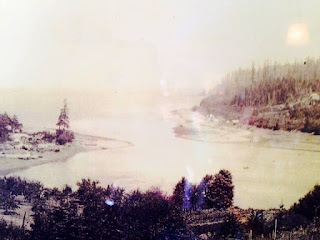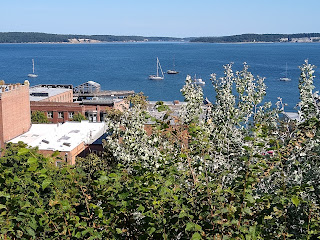From the Seattle Public Library Special Collections, a 1882 view of the Seattle waterfront at the approx base of Vine St. Cedar and Broad Streets by Asahel Curtis. (View in Collections) Looking northeast.
4/14/22
"Seattle Waterfront. 1882-1886. Canoes and Indians in Belltown. Foot of Vine St. Cedar and Broad St. Photo by Asahel Curtis."
3/30/22
Salmon Bay Entry Before and After Ballard Locks Dredging
Here's two glimpses of images showing Seattle's Salmon Bay's entry into Shilshole Bay before the Chittenden (or Ballard) Locks dredging and the current view.
The Shilshole people called the mouth of Shilshole 'sHulsHOOLOOTSeed'
Originally the channel had a few sandbars stretching across and was wade-able at low tide. Shilshole means 'like shoving a thread through a bead.'
Before dredging, a large sandbar existed (seen here) on top right on the Ballard side just south of Ray's Boat house, called 'Hanging on the Shoulder' or KeehLalabud.' The sandbar was known for good clamming. Photo: MOHAI.
Dredging for the Locks occurred around 1915 ish.
As 'settlers' arrived and built logging mills upstream in downtown Ballard, boats could only enter or exit at high tide.
The image above shows tall masted ships moored in Shilshole Bay probably waiting for the tide and their turn to enter the narrow mouth.
Here's a 'Washington Territory' pre-Locks chart of the same area showing sand bars and undeveloped shoreline of Salmon and Shilshole Bays.
2/25/22
When it was Cool to Burn Ships on Puget Sound..
As the maritime industry moved away from wood and more into steel hulls, the older boats were discarded, grounded or burned.
On Puget Sound, it became a common practice to burn the old ships from the 1920's to the 1950's. At low tides, scrap metal would be recovered.
Families would come out and set up a picnic while watching ships burn along the shore at Richmond Beach and other spots along the Sound.
Assuming this was before the environmental movement.
Here's one from Richmond Beach titled by MOHAI as "Burning hull of the steam tug "Daniel Kern," April 1939". Read more about the Kern here
Read more about the Richmond Beach burning events at this link, called the Ronald Blog - Click Here
Here's a Google Maps view of the beach north of Picnic Point where a few were burned or grounded.
The SS Bering, a former reindeer ship was bought by the Tregoning Boat Company in Ballard (Seattle) and was beached at what is now called Secret Beach.
In 1964 it was burned to make way for shore development such as the Ballard Elks Lodge. I wrote about the SS Bering in this blog post from 2000.
Older Elks members told me they played on the ship as kids, one jumping off of it into the water. At low tide you can still find burned pieces of wood with bolts and nails on the beach there.
2/11/22
More tall ships...but this time in Port Angeles Harbor
The photo above was posted to a Facebook group I've joined, called Historic Olympic Peninsula, without attribution or credit. But it was so striking that I decided to re-post it here...if any viewers know where this one is from please let me know. The poster dated it to roughly 1895, and its a view of downtown Port Angeles, taken from about here and looking north. Two things jumped out at me. First, the tall ships in the harbor reminded me of my last post, which focused on tall ships anchored off of Port Townsend in 1891. Second, this photo pre-dates, but about two decades, the filling of downtown Port Angeles, which is a focus of a few of my previous posts. This view really provides a nice perspective on Port Angeles as a built-on-the-beach town. Here is the modern view (February 2022):
11/30/21
Tall ships in Port Townsend Bay
This 1891 view of Port Townsend Bay is enchanting for so many reasons - the bay loaded with tall ships (and one hybrid steamer), the impressively crafted buildings and docks, and the streetcar in the near frame, and the sand roadways:
 |
| 1891 view of Port Townsend and Port Townsend Bay. Image credit: Bert Kellogg collection. |
11/3/21
From Craven Peninsula to Port Townsend Canal
In 1841 explorer Charles Wilkes named the small stretch of gravel connecting Port Hadlock with Indian Island Craven Peninsula after a member of his crew, Lt Charles Craven.
The peninsula was submerged at high tides. Natives and later settlers portaged over the peninsula at high tides.
As early as the mid 1800's, there was interest in dredging the peninsula to make the channel a channel for shipping.
Finally in 1915, the peninsula was dredged and a canal was created. Local residents were promised a bridge that didn't come until 1952. Prior, residents and later the Navy on Indian Island used a variety of boats and later ferries to cross the channel.
Read more about the story of Craven Peninsula, the dredging, ferries and the bridge on this link:
10/7/21
Restoration and change on the Elwha River delta
Another perspective on short-term change on the shoreline associated in part with restoration (like this post from June), again on the Elwha River delta (like this post from 2020). This particular location is on the east side of the Elwha River delta, and was eroding rapidly between 2011 and 2015. Here is what the site looked like in 2011:
 |
| May 2011 photo of the beach on the Elwha River delta, looking up the beach from the low tide line. |
By late 2013 the beach was heavily eroded, revealing large boulders on the beach, part of a failed defensive rip-rap structure built at some point in the past:
 |
| September 2013 photo |
 |
| July 2016 photo |
 |
| July 2018 photo |



















